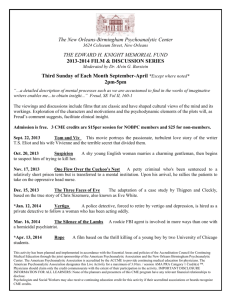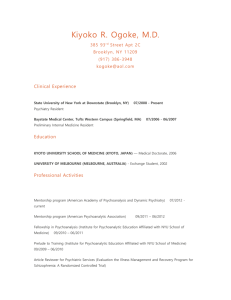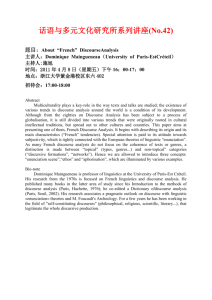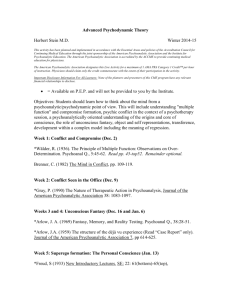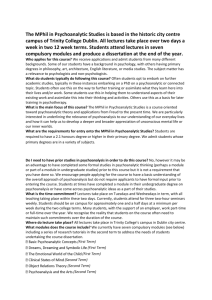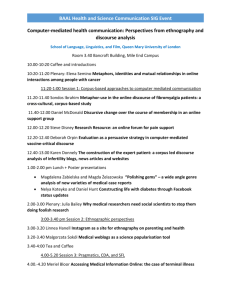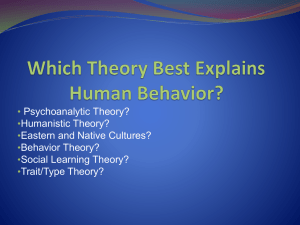1995 Haworth Book Discursive Complexes
advertisement
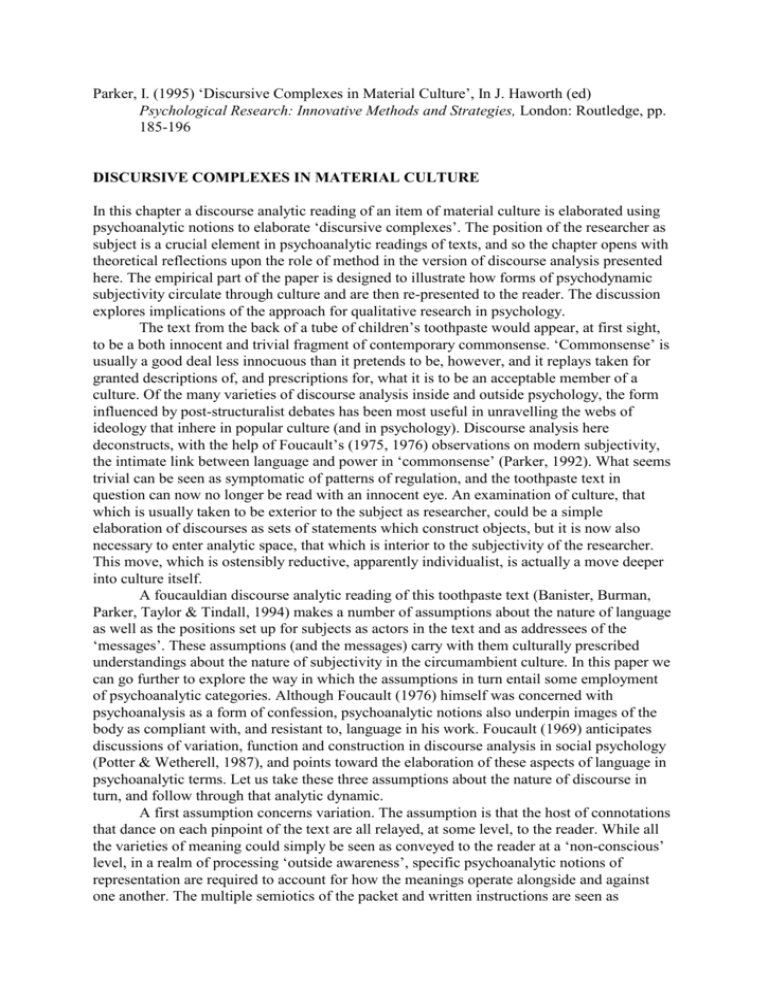
Parker, I. (1995) ‘Discursive Complexes in Material Culture’, In J. Haworth (ed) Psychological Research: Innovative Methods and Strategies, London: Routledge, pp. 185-196 DISCURSIVE COMPLEXES IN MATERIAL CULTURE In this chapter a discourse analytic reading of an item of material culture is elaborated using psychoanalytic notions to elaborate ‘discursive complexes’. The position of the researcher as subject is a crucial element in psychoanalytic readings of texts, and so the chapter opens with theoretical reflections upon the role of method in the version of discourse analysis presented here. The empirical part of the paper is designed to illustrate how forms of psychodynamic subjectivity circulate through culture and are then re-presented to the reader. The discussion explores implications of the approach for qualitative research in psychology. The text from the back of a tube of children’s toothpaste would appear, at first sight, to be a both innocent and trivial fragment of contemporary commonsense. ‘Commonsense’ is usually a good deal less innocuous than it pretends to be, however, and it replays taken for granted descriptions of, and prescriptions for, what it is to be an acceptable member of a culture. Of the many varieties of discourse analysis inside and outside psychology, the form influenced by post-structuralist debates has been most useful in unravelling the webs of ideology that inhere in popular culture (and in psychology). Discourse analysis here deconstructs, with the help of Foucault’s (1975, 1976) observations on modern subjectivity, the intimate link between language and power in ‘commonsense’ (Parker, 1992). What seems trivial can be seen as symptomatic of patterns of regulation, and the toothpaste text in question can now no longer be read with an innocent eye. An examination of culture, that which is usually taken to be exterior to the subject as researcher, could be a simple elaboration of discourses as sets of statements which construct objects, but it is now also necessary to enter analytic space, that which is interior to the subjectivity of the researcher. This move, which is ostensibly reductive, apparently individualist, is actually a move deeper into culture itself. A foucauldian discourse analytic reading of this toothpaste text (Banister, Burman, Parker, Taylor & Tindall, 1994) makes a number of assumptions about the nature of language as well as the positions set up for subjects as actors in the text and as addressees of the ‘messages’. These assumptions (and the messages) carry with them culturally prescribed understandings about the nature of subjectivity in the circumambient culture. In this paper we can go further to explore the way in which the assumptions in turn entail some employment of psychoanalytic categories. Although Foucault (1976) himself was concerned with psychoanalysis as a form of confession, psychoanalytic notions also underpin images of the body as compliant with, and resistant to, language in his work. Foucault (1969) anticipates discussions of variation, function and construction in discourse analysis in social psychology (Potter & Wetherell, 1987), and points toward the elaboration of these aspects of language in psychoanalytic terms. Let us take these three assumptions about the nature of discourse in turn, and follow through that analytic dynamic. A first assumption concerns variation. The assumption is that the host of connotations that dance on each pinpoint of the text are all relayed, at some level, to the reader. While all the varieties of meaning could simply be seen as conveyed to the reader at a ‘non-conscious’ level, in a realm of processing ‘outside awareness’, specific psychoanalytic notions of representation are required to account for how the meanings operate alongside and against one another. The multiple semiotics of the packet and written instructions are seen as ‘overdetermined’ (that is, arising from many different patterns of meaning at one and the same time). The space for one meaning does not prohibit another from functioning, and the meanings do not necessarily operate upon the reader sequentially. The text, like the unconscious, is seen as knowing no time nor logical contradiction, in the sense that variation, as illogical contradiction, reigns as a condition for what we take to be coherence (as we fix one meaning and disregard the others that are necessary to give it a particular context and form). It matters to us, of course, that the meanings in the text flood into the subject whether they know it or not or want that to happen, and any discourse analytic reading of texts is to some extent therapeutic. A second assumption concerns function, and the way that the text produces certain effects upon a reader. Once we break from seeing function as the deliberate exercise of ‘interests’, we move into the realm of the unconscious, and of unconscious meanings addressing and catching the reader’s unconscious. The experience of the reader as addressee is transformed in the process of reading such that they are locked in some way into the discursive structure of the text. One way of conceptualising this, following Althusser’s (1971) account of the work of ideology, is to say that the reader is ‘interpellated’, or hailed by the text, and that any response to the text, whether that response indicates agreement with the message, or resistance to the claims the text is making about the nature of the reader and prescriptions for action being formulated for them, is conditioned by this interpellation. A good way of describing this process is to employ the notion of ‘subject position’, with the reader being seen as positioned as a form of subject at different points in the text. Again, the view that we bring to the analysis concerning overdetermination of meaning in the text allows us to see multiple subject positions as formed simultaneously and in contradiction to one another. The positions that are constituted for the addressee may be complementary on occasion, but language also routinely disrupts our sense of self, and we anxiously and perpetually smooth it over to keep ourselves together. Psychoanalytic discourse analysis opens the contradictions in subject positions, and so too the contradictions in the subject caught in the text. The third assumption concerns the construction of the meaning in the text, as a relatively enduring semantic structure that ‘holds’ the reader in position. While there is undoubtedly the reconstruction of sense moment by moment on the different occasions the text is read, there are also patterns of meaning, the discourses as sets of statements that constitute objects, that return to the reader. These patterns are relayed in the wider culture that hosts the text and the reader, and replayed as the organized tacit conditions for sense that makes it possible for the text to work. The kinds of reader or ‘subject’ constituted in the culture (subjects schooled in talk of the unconscious, infantile sexuality and suchlike) come to the text prepared to read particular constellations of signs (keywords, turns of phrase, and allusions to what is ‘other’ to the text) that have been fabricated as part of the underlying commonsense of the culture (Parker, 1993). Here it useful to read the culture alongside the text as composed of ‘discursive complexes’ which relay meaning and specify subject positions. The step that we take into an analysis of discourse as a patterned field of signification as well as an accomplishment of individual speakers then leads us to take seriously cultural resources that individuals draw upon to fashion themselves as competent selves. Psychoanalysis is a potent element in the discourse of selfhood in Western culture, and so discourse analysis should itself draw upon that resource in the research process. Method Three aspects of psychoanalytic method as it pertains to discourse research can be identified, and these will be employed during the analysis of text in question in this chapter. The first concerns the sensitivity of the researcher, and the ways in which the subjective resources of the reader are brought to bear on the material. These resources are structured, in the process of a psychoanalytic reading, by transference (what is brought to the unconscious relationship the reader has to the text by the text, and its host culture) and counter-transference (what is brought to the text by the reader, and the culture they inhabit). The subjectivity of the reader is mobilised by this dual relationship and gives rise to certain responses (which emerge in the course of the reading) and inhibitions (which obscure a relationship with the intersubjective field that constitutes a text within a symbolic community). It is easier, of course, to display and reflect upon responses than it is to do so with inhibitions, but the analysis can attempt to keep present to attention the ways in which ‘absences’ and ‘otherness’ to the text is systematically structured. The symptomatic reading that results will take the form of systematic speculation around the points where the text does not make ‘sense’. The second aspect concerns the form of the reading, and the ways in which psychoanalytic concepts are brought to bear on the text to open up the semantic (and so, also, discursively constituted psychic) mechanisms that organize it. Psychoanalysis is treated here as a methodological vocabulary which is deployed to restructure the text in terms that render unconscious defences and libidinal forces meaningful as linguistic patterns. The aim here is not to uncover such defences or forces in the ‘author’ of the text (though an imagined author may be produced at some point to facilitate the reading), but to focus on the patterns in the text, in the relationship it provokes with the reader and in the relationship it reproduces (as mediator) between the reader and culture (and so wider systems of discourse). At each point of focus psychoanalytic vocabulary reframes and elaborates what may be going on. In the case of the patterns in the text psychoanalytic terms can be kept at a distance (as if they simply existed in the material), but the relationship between the text and reader and the relationship it re-marks between the reader and the culture includes us (and the overall analytic frame is again that of transference and counter-transference). The third aspect concerns the way forms of culture are represented in the text, and in particular the way in which psychoanalytic culture is transmitted in discourse (directly or indirectly, deliberately or unintentionally). A reading of culture as a meshwork of discourses which can be analytically decomposed needs to be connected here with a cultural history of the different forms of subjectivity (and the emphasis for these purposes is on psychoanalytic subjectivity) that are constituted for readers now. Psychoanalytic notions which thread through Western twentieth-century culture are located in the text here as ‘discursive complexes’ which simultaneously carry discourses and elaborate sets of subject positions for actors in the text and for readers of the text. Discursive complexes are patterns of meaning that systematically form objects and subjects, but their internal structure derives from psychoanalytic discourse. Notions of childhood ‘complex’, the ‘ego’ and the ‘unconscious’ together with the panoply of strategies that one may use to reflect upon these objects (‘acting out’, ‘repetition’, ‘working through’ etc.) circulate as elements of self-understanding in Western culture. A psychoanalytic discourse reading does not treat these notions as given, but looks to the ways in which texts reproduce such categories, and reproduce subjects who can make sense of the texts that hold them. The text The back of the toothpaste tube contains, in blue type, the following instructions: DIRECTIONS FOR USE Choose a children’s brush that has a small head and add a pea-sized amount of Punch & Judy toothpaste. To teach your child to clean teeth, stand behind and place your hand under the child’s chin to tilt head back and see mouth. Brush both sides of teeth as well as tops. Brush after breakfast and last thing at night. Supervise the brushing of your child’s teeth until the age of eight. If your child is taking flouride treatment, seek professional advice concerning daily intake. Contains 0.8% Sodium Monoflourophosphate The tube is small, like other tubes of toothpaste for children, and white. The front of the tube has, in large red letters with blue shadow, the legend ‘PUNCH & JUDY TOOTHPASTE’. The manufacturer’s name (‘Maws’) is above in silhouette on a blue background, and there is a line below, in red, which reads , ‘Children’s Toothpaste with Flouride’. A border of red strawberries (with blue leaves) circles each end of the tube, and eight more strawberries are dotted around on the front. There is a picture on the front of the tube, and again next to instructions, of the head of Punch smiling and holding a red toothbrush in his mouth. He wears a blue ruff around his neck and a red frill around his one visible hand (which holds the brush). Analysis A preliminary analysis (Banister, Burman, Parker, Taylor & Tindall, 1994), following methodological steps outlined in Parker (1992) which trace the clusters of objects, subjects and social relationships that are specified in the text, concluded with an outline of four discourses. These were: ‘rationalist’ - in which the ability to follow procedures (‘directions for use’) requires choices of implement and judgement of amount (‘small head’ and ‘pea-sized amount’) and is predicated on recognition of appropriate authority in health care (following ‘directions’ and seeking ‘professional advice’); ‘familial’ - in which ownership (‘your child’) runs alongside supervision and continuous care (the assumption that the child is present each breakfast and ‘last thing at night’) and is framed by the image of bad parenting (the figure of ‘Punch & Judy’); ‘developmental-educational’ - in which the teaching of the child (parental activity) precedes supervision (the child’s still tutored but self-governed activity) and then reaches an identifiable stage as a developmental milestone (the ‘age of eight’); and ‘medical’ - in which the process of using the toothpaste is necessarily linked to hygiene (brushing after meals), professional supervision (‘flouride treatment’) and the specification of ingestion and chemical composition of substances (‘daily intake’, ‘0.8% Sodium Monoflourophosphate’). An essential part of discourse analysis is the production of a ‘critical distance’ between the reader and the text so that one is able to ask what collections of relationships and theories of self must obtain for this material to make sense. That step back can go as far as to throw into question the material conditions that would be necessary for the text to ‘work’. There are, for example, background assumptions about the nature of memory and the activity of teethcleaning as a private activity for which tutoring (through the medium of the text) is appropriate, and the text operates as a practice in a world of toothbrushes, running water and electric light (to see the teeth last thing at night). The psychoanalytic construction, function and variation in the text can also be approached through exploring the conditions of possibility for these notions to work in this culture as conditions of possibility for psychoanalysis itself. One can ask how such aspects of the world (privatised hygiene, personalised advice and self-regulation) also incite forms of behaviour, experience and reflection that are amenable to psychotherapeutic, psychoanalytic talk. Two further methodological points of focus can be illustrated here. The first concerns ‘feeling’, forms of inchoate response to the text which cannot be tied one to one to terms or phrases. Psychoanalysis is centrally concerned with the organization of affect, and the analysis of meaning, which discourse analysis is capable of addressing, needs now to be supplemented with an analysis of the ‘drives’ in the text. This is not to say that actual libidinal forces pulsate through the text, but that meanings are structured such that they operate as dynamic, and then for the reader as psychodynamic, forces. The case in point here is how one would be able to capture the violence in the text. An activity is represented here in which the child is physically restrained while a cleaning implement is inserted in the mouth. There is powerful affect running alongside meaning, and it is helpful to attend to our ‘emotional response’ to the text, to images in the text here as varieties of affect produced in discourse. The violence is distributed around certain oppositions, which are then mapped onto subjects (the parent and the child) specified in the text. The second methodological point of focus concerns the elaboration of oppositions, and their particular relationship to domination and compliance (and to force and resistance). It is useful to attend to forms of splitting in the text, with the production of oppositions which can be read deconstructively to open up the text as a cultural practice, for to open the text up in this way reveals the operations of power that privilege certain practices. This point extends a ‘deconstructive’ reading of texts (Parker, 1988). In this case the pair ‘adult-child’ is mapped onto ‘reality-pleasure’ (ensuring hygiene versus enjoying the taste), ‘knowledge-naivety’ (following instructions versus being supervised) and ‘work-play’ (teaching the task versus consuming jolly toothpaste), and - this is where the violence is reproduced - onto the opposition ‘active-passive’. The activity and passivity in the text are also replayed in the relationship of the text to reader, with the recipient of advice subordinate to the addressor (as subject supposed to know) and professional (in alliance with the addressor). These considerations are now of assistance in building upon the initial description of the four discourses to produce a psychoanalytic reading, and thus to the elaboration of ‘discursive complexes’. Discursive complexes as, simultaneously, forms of discourse and relays of psychoanalytic subjectivity can be used as analytic devices to connect the material in the text with broader cultural patterns. Discursive complexes take the form of psychoanalytic concepts, but should be understood as socially constructed, symbolically maintained, not as reflections of individual psychic states (though it will indeed be the case that an individual ‘subjected’ to such symbolic material is constituted as a ‘psychoanalytic subject’ for whom such a mode of interpretation will then make sense). The oedipal triangle Although the Oedipus complex is so important in psychoanalysis, Freud declined to call it a ‘complex’ until 1910, fourteen years after he first puzzled over the fraught connection the infant has with the first love object (in Western nuclear families, usually the mother) and then with the first threat (usually the father, as the third term in the relationship). The image of the oedipal triangle structures the internal psychic economy of the infant, and as a discursive form it both structures and disrupts the opposition in this text between ‘adult’ and ‘child’. The repression of gender as a category in this text, marked by the absence of gendered possessive pronouns (‘to clean teeth’, ‘sides of teeth’), also raises a question about the gender of each of the participants in the scene enacted here. Gender is absent in cultural conditions which are saturated by gender. Why? And why should the relationship between addressee and infant (‘your child’) be violent, violating? The clue which solves both questions is the motif of Punch and Judy, and that motif is relayed into the text by the figure of Punch. Punch and Judy function here as exemplars of aberrant abusive parents, and Punch alone operates in a double position as representative of the Law (the third term with the stick, which in this case is also the toothbrush which he holds in his mouth) and as violator of the Law (with the stick as the weapon with which he batters the child, and Judy). Zizek (1991), employing psychoanalytic theory, has pointed out that the Law always produces excess, supplementary unlawful violence as a condition for the Law to function. A supplement father in the Punch and Judy narrative, the policeman, then enforces the Law as good parental figure, and a further splitting in the narrative produces the crocodile (who traditionally, it can be noted, has big white teeth) as the excess of violence which threatens all three in the triangle. The ‘adult-child’ couple, then, is overlaid by a particular affective shape which is given by the discursive complex of the oedipal triangle, and it is then possible to account for the splitting between the activities of (health) care in the text and the (regulative) violence of the text as a screen for that which is excluded (Oedipus). The reality principle In the Punch and Judy narrative which both frames the activity specified in this text and functions as a warning as to the characteristics of parents who would fail to follow these instructions, Punch is the figure who shouts ‘That’s the way to do it!’. Punch initiates the infant, and the audience (of children) into a form of violent (ir)rationality, a surplus of enjoyment in the puppet narrative which is also, for the battered baby, and Judy, beyond the pleasure principle. The discursive complex of the reality principle is useful here to capture the opposition ‘reality-pleasure’ that underpins this text. Mouth hygiene is on the side of reality, and enjoyment of the taste on the side of pleasure, but the opposition carries much more besides. The opposition comes all the closer to psychoanalytic notions of reality (the social) and pleasure (the body) when it is mapped onto other oppositions that are operating in this material. In this discursive complex, the irrational and the rational are also mapped onto the relationship between the body and language. The untutored child is physically restrained, and the body is moved into positions that will facilitate the eventual supervision (as a moment of transition between the pleasure of the infant and the reality of the adult world) and then self-governance of the child (after eight) who is able to ‘clean teeth’. While the child’s body is physically positioned, the adult (the addressee) is positioned as a rational subject through language. The adult is constituted as a being who can be addressed through language (in this case, written instructions), and the relationship with authority (the addressor, as ‘subject supposed to know’, the imaginary author of the instructions) is symbolically mediated. The seeking of ‘professional advice’ will also be carried out through the medium of language. In this opposition, then, the body is irrational (to be tutored), child, and the mind is rational (to be addressed), adult. The opposition also encourages a particular commonsense ‘theoretical’ reflection - that which one finds in Althusser’s (1971) attempt to produce a psychoanalytic account of ideology for example - on the way in which one is inducted into society as a physical practice, something that can be set in contrast to the ways in which one then reflects upon society as a linguistic achievement. Enigmatic signifiers The opposition between the adult and the child also carries a contrast between knowledge and naivety, in which one member of the pair is able to follow instructions, and the other follows the route to knowledge through supervision from ignorance. The naivety of the child is also important to psychoanalysis, which adds a paradoxical twist to images of childhood innocence. For while the child is seen as outside the social order, innocent of the nature of reality (and following the pleasure principle) it is in its nature (also following the pleasure principle) to be driven to know. What the child experiences of sexuality, for example, is not yet linked with what it is possible to know, and what it is possible to know of sexuality as adult knowledge will both articulate and transform what the child once experienced. The paradox of the innocent child surrounded by, and affected by, adult mysteries which it cannot yet comprehend can be grasped, picking up a term used by the analyst Laplanche (1987), through the discursive complex of ‘enigmatic signifiers’. In this text, however, apart from questions of sexuality (obscured and operative through the absence of gender), there are questions of power and violence; that which is incomprehensible to the child (as physical restraint) will be rendered meaningful as the child reaches a certain developmental point. Here the penetration of the child’s body (their mouth) is linked to a form of knowledge (and the practice of a form of knowledge). The description here is technical, positions the child as an object, and the parent maintains the child as if they were a mechanism (which then, at some developmental point, becomes sentient). Reading the text through the figure of enigmatic signifiers also throws further light on the riddle of the ‘violence’ of the text. The activity of brushing the interior of the mouth after restraining the head is a scene in which an adult with power gazes upon and acts upon the child. There is then a resonance between objectification of the child (as innocent object with the wish to become subject) and accounts of objectification in pornography. The flouride is also marked as an object to be inserted, as ‘intake’, as a substance to be placed into the child, and the toothbrush functions metaphorically as a ‘speculum’ (a device for observing the interior of the body and producing knowledge) constituting the space (the mouth, the tutored child) from which discourse will one day emerge. Sites of resistance It would be possible to provide a quasi-foucauldian reading of the text as a sealed world in which processes of regulation and surveillance constitute all the limits and interior space of what it is possible to do and know. However, the opposition ‘work-play’, the contrast between the teaching of the task and the consumption of the jolly toothpaste, opens a space for manoeuvre, a space that a psychoanalytic reading should exploit. There is a carnivalesque resistance in the form of Punch and Judy. Rather like the anarchic vision of ‘schizophrenia’ in Deleuze & Guattari’s (1977) Anti-Oedipus, Punch and Judy are provoked as a condition of the text, and to work efficiently to support the text as instruction they must be limited, bounded, contained, so that their subversive potential cannot be realised. They are produced to the limit (and to regulate the limits) of what is rational (against the irrational). The text is part of a machinery of desire (and, for Deleuze & Guattari, of capitalism); it incites play to sell a commodity and then turns that into work to reproduce the relations of power that make such commodities possible. What makes it possible for this text to work is that the child (and the reader positioned as a child, in identification with the child, as they buy the text) is lured into the scene. The subjugation and training of the child is facilitated by the images of play, and the reader is drawn into the text as a player with power, but not in command of the apparatus of power (that is, the powerful subject is also subject to the power). However, a foucauldian account of power is always also an account of resistance, and to speak of a discursive complex of ‘sites of resistance’ allows us to elaborate how that resistance may operate in the psychic economy of readers. The very process of luring the child (and adult identified as child) into the text provokes the fantasy of disruption, the transformation of the supervision scene into play. Punch, for example, is the Law and the disruptor of the Law, and at the very moment that he exercises the Law to the full he throws it into question. This reading of the text also throws it into question, and psychoanalysis, as a theory of resistance, opens a space from which we may think against the text, mark ourselves as different to the subject positions it creates for us and within us. Discussion Some further consideration should now be given to method, and in particular to the cultural location of psychoanalysis as a lens through which to view subjectivity and as a vocabulary by means of which a reading of a text can be articulated. It would be possible to argue (as many psychoanalytic practitioners and theorists do) that psychoanalysis provides a vivid insight into the psychic economy of the paraphernalia of material culture because it accurately addresses the internal forces and relations of the individual human subjects that produce (or write) and consume (or read) it. No such claim is being made here, and if anything, the opposite. For research subjectivity and psychoanalytic structures are seen in this chapter as constituted by the culture they inhabit. That is, transference, counter-transference, defence mechanisms and libidinal forces are themselves seen as semantic forms which circulate through ‘discursive complexes’. In this case, therefore, the reading of a text which is ostensibly so apparently innocent of the unconscious has to be ‘re-read’ as it is reconstituted as a piece of material in a psychoanalytic culture. This chapter has employed psychoanalytic notions in the broadest sense to elaborate a discourse analytic reading. Although there has been reference to particular theories within the Freudian and post-Freudian tradition, my concern has been with the most general culturally available analytic images of the family, rationality, curiosity and resistance. The Lacanian tradition as been particularly useful in this reading, with the work of Althusser (1971), Deleuze & Guattari (1977), Laplanche (1977) and Zizek (1991) throwing light on the work of ideology, resistance, knowledge and power. It is important to note that the ways we can reflect on the operations of this text as researchers are also conditioned by the very forms of discourse that inhabit the text. Here, then, we should be aware of assumptions in the Lacanian tradition that frame our interpretation. In the case of the infant being inducted physically into language and the adult reproducing that practice through the medium of language, for example, we should take care to see this as an account of ideology, not necessarily as an accurate explication of its nature. This theoretical, and psychoanalytic, reflection is expressed, among other places, in Althusser’s (1971) writing which counterposes the induction of the subject into ideology as a practice (of ‘ideological state apparatuses’ such as the school) to the theoretical practice and scientific reflection upon ideology as conducted through the symbolic order. Similar points could be made about the specific cultural location of Deleuze & Guattari’s celebration of ‘schizophrenia’ as resistance, Laplanche’s description of the child puzzling over adult sensual knowledge and Zizek’s view of the Law as always provoking its hideous reverse. The analytic device of the ‘discursive complex’ is used to provide a more thoroughly embedded notion of subject position than that offered by, for example, Davies & Harr╤ (1990). The position taken by the subject is not adopted moment by moment as an individual engages with the material, but is discursively given to the reader. This does not mean that the reader is passive, but that certain conditions of possibility for the text also permit certain relationships to be formed within the text and, from within other texts, towards and against it. The engagement with any text is always an engagement from within discourse, and the task of a discourse analytic reading is to engage in a way that lays bare the work of ideology and the plays of power, the unravelling of ideology and the spaces of resistance (Parker, 1992). In the research process the subject positions, and general issues of activity and passivity in the text, are compounded by the process of reading as the struggle for mastery over the text. Different forms of identification are produced in the text, as actors in the text operate as exemplars of subject positions that can be adopted or refused. The analysis has adopted a subject position (of researcher) which also speaks about what is excluded (repressed), and an active position is taken in relation to regions of the symbolic order that are usually closed. The subject position of the researcher can then also be drawn out using psychoanalytic theory. There are risks. In this case the gaze of the psy-complex (the array of theories and practices that comprise the discipline of academic and professional psychology) is reproduced in the activity of the parent regulating, through the supervisory gaze, the child. The developmental-educational discourse that runs through the text is interwoven with images of the rational individual, the family and medicine, and this cluster of discourses reinforces the power of psychology as a ‘regime of truth’ (Banister, Burman, Parker, Taylor & Tindall, 1994). The researcher using psychoanalytic theory as described in this chapter now gazes upon the text, and upon the parent and child, in a metaposition that is actually still of a piece with the activities of the psy-complex. The regulation of children is a condition for the psy-complex, and it is important to remember that it is also a condition for psychoanalysis (and now for us) as part of (and other of) the psy-complex. Acknowledgements I would like to thank Erica Burman for help with versions of this chapter. References Althusser, L. (1971). Lenin and Philosophy, and other essays, London: New Left Books. Banister, P., Burman, E., Parker, I., Taylor, M. & Tindall, C. (1994). Qualitative Methods in Psychology: A Research Guide, Milton Keynes: Open University Press. Davies, B. and Harr╤, R. (1990). Positioning: The discursive production of selves, Journal for the Theory of Social Behaviour, 20, 1, 43-63. Deleuze, G. & Guattari, F. (1977). Anti-Oedipus: Capitalism and Schizophrenia, New York: Viking. Foucault, M. (1969/1972). The Archaeology of Knowledge, London: Tavistock. Foucault, M. (1975/1977). Discipline and Punish, London: Allen Lane. Foucault, M. (1976/1981). The History of Sexuality: Volume One, An Introduction, Harmondsworth: Pelican. Laplanche, J. (1977/1979). New Foundations for Psychoanalysis, Oxford: Blackwell. Parker, I. (1988). Deconstructing Accounts. In C. Antaki (Ed). Analysing Everyday Explanation: A Casebook of Methods, pp. 184-198, London: Sage. Parker, I. (1992). Discourse Dynamics: Critical Analysis for Social and Individual Psychology, London: Routledge. Parker, I. (1993). Social constructionist psychoanalysis and the real. In B. Kaplan, L. Mos, H. Stam & W. Thorngate (Eds). Recent Trends in Theoretical Psychology (vol. III),, pp. 41-49, New York: Springer-Verlag. Potter, J. & Wetherell, M. (1987). Discourse and Social Psychology: Beyond Attitudes and Behaviour, London: Sage. Žižek, S. (1991). For They Know Not What They Do: Enjoyment as a Political Factor, London: Verso.
